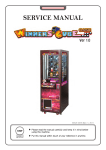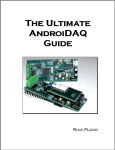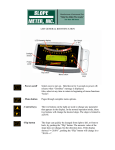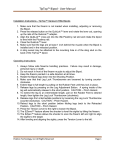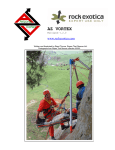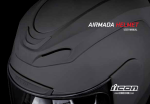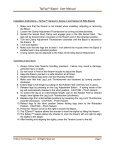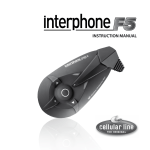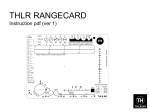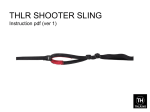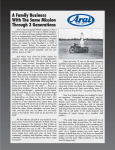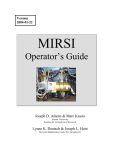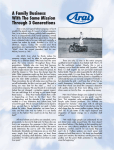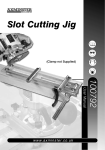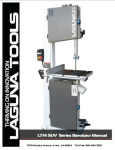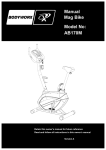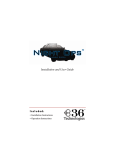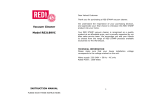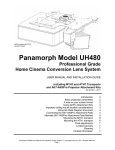Download THLR Shooter Error user manual
Transcript
THLR SHOOTER ERROR Instruction pdf (ver 1) •• ••• ••• •• •• •• • • •• •• •• •••• ••• • •••• • •• •••• POOR BIPOD PRESSURE THLR.NO PULLING TRIGGER OR GRIP PUSHING RIFLE FORWARD WITH SHOULDER POOR POINT OF AIM OR POOR SHOOTING NO NATURAL POINT OF AIM PUSHING FROM LEFT/RIGHT NO NATURAL POINT OF AIM PUSHING RETICLE DOWN 1) 2) 3) RIFLE BUTT TOO LOW ON SHOULDER NECK TENSION/ CHEEK PRESSURE PUSHING RETICLE UP COMMON SHOOTER ERRORS THLR SHOOTER ERROR Main features •• ••• 1 1 1 1 1 1 1 ••• •• •• •• • • •• •• •• •••• ••• • •••• • •• •••• POOR BIPOD PRESSURE THLR.NO PULLING TRIGGER OR GRIP PUSHING RIFLE FORWARD WITH SHOULDER POOR POINT OF AIM OR POOR SHOOTING NO NATURAL POINT OF AIM PUSHING FROM LEFT/RIGHT NO NATURAL POINT OF AIM PUSHING RETICLE DOWN 1) 2) 3) RIFLE BUTT TOO LOW ON SHOULDER NECK TENSION/ CHEEK PRESSURE PUSHING RETICLE UP COMMON SHOOTER ERRORS 1. Depiction of common bullet groups/ patterns on a target and a description of the most common errors that cause similar patterns* when shooting from the prone position with a bipod. *It is assumed that ammunition, rifle and other equipment is without fault. THLR Shooter Error describe only the shooter so he can focus his training. THLR SHOOTER ERROR Main features •• ••• POOR BIPOD PRESSURE Poor bipod pressure. The bipod pressure can be «poor» in several ways. You can push the rifle too hard against the bipod TRY THIS: Make sure bipod height is adjusted correctly so you can maintain a relaxed natural point of aim towards your target. Most bipods are a little wobbly and have some play moving, allowing you to move the rifle slightly forward and backwards. Push the rifle very carefully forward. Stop when forward play is gone, and there is a gentle but firm contact. When you find the amount of pressure your bipod works best with, try duplicating this pressure by pushing your whole body forward into the rifle using mostly your toes. This makes it very hard to put too much pressure and also makes it easier to avoid pushing your shoulder into the rifle. Hopefully this will reduce the frequency of bullets striking up to the left. THLR SHOOTER ERROR Poor bipod pressure •• ••• POOR BIPOD PRESSURE Poor bipod pressure. The bipod pressure can be «poor» in several ways. You can push the rifle too hard against the bipod TRY THIS: Make sure bipod height is adjusted correctly so you can maintain a relaxed natural point of aim towards your target. Most bipods are a little wobbly and have some play moving, allowing you to move the rifle slightly forward and backwards. Push the rifle very carefully forward. Stop when forward play is gone, and there is a gentle but firm contact. When you find the amount of pressure your bipod works best with, try duplicating this pressure by pushing your whole body forward into the rifle using mostly your toes. This makes it very hard to put too much pressure and also makes it easier to avoid pushing your shoulder into the rifle. Hopefully this will reduce the frequency of bullets striking up to the left. THLR SHOOTER ERROR Pulling trigger or grip ••• •• PULLING TRIGGER OR GRIP Pulling trigger or grip. TRY THIS: The most obvious mistake is not pulling the trigger correctly (moving trigger only), but pulling with your whole hand and pulling the rifle towards you. Simplest fix is making sure you are moving ONLY your trigger finger and pulling ONLY the trigger. Your trigger hand must hold the rifle with the same amount of pressure each time. Check the pressure of the muscle right over your elbow, if it is tense, you are likely pulling the grip. Move your elbow position so your upper arm rests. A too long stock or too thick grip will usually cramp your arm and you will pull on the trigger out towards your shooting elbow. A too short stock or too thin grip will feel like you are without stability in your shooting wrist and you will push the trigger in towards your heart. THLR SHOOTER ERROR Pushing rifle forward with shoulder •• •• • PUSHING RIFLE FORWARD WITH SHOULDER Pushing rifle forward with shoulder. TRY THIS: Your shoulders are very vulnerable when shooting. Mental stress in hunting or competition often causes humans to pull the shoulders slightly up; it is part of our embedded «flight or fight» response. Not achieving a properly rested position or shooting from improvised field positions can also cause same stress. Following a target moving towards the left can also cause the same effect if the shooter does not correct his position, but rather just muscles the rifle onto the target. Total relaxation in the shooting shoulder is of utmost importance in the prone position. Very small changes in pressure will greet the recoiling rifle with very different responses and caise different point of impacts. If you make total relaxation a checkpoint in the building of your shooting position, you more or less eliminate the possibility of pushing the rifle with the shoulder. If you are following a moving target, move elbow – hip – feet as soon as you feel the shoulder tense and you will drop into a neutral, relaxed position again. THLR SHOOTER ERROR Poor point of aim or poor shooting • •• •• POOR POINT OF AIM OR POOR SHOOTING Poor point of aim or poor shooting TRY THIS: Don’t just shoot at the target. Break the trigger when the reticle is exactly where you want it to be. In case of a «reticle wobble», break the trigger with the reticle moving into the target. In case of plain poor shooting, we would recommend a local resource for tuition/ training. A good instructor will expedite your learning a lot more than this text. THLR SHOOTER ERROR No natural point of aim, pushing from left/right •• •••• ••• • •• •••• • • NO NATURAL POINT OF AIM PUSHING FROM LEFT/RIGHT No natural point of aim, pushing from left/ right • •••• •• • • •••• •• • TRY THIS: We’ve divided «no natural point of aim» into two groups. Recoil combined with a shooting position not solid enough can slowly push natural point of aim off target and eventually cause a flier. The shooter recognizes the reticle is not on target, but he fails to recognize he just pushed the reticle back on target using muscle. If the error frequently occur, try changing your position so your straighter behind the rifle and get the rifle butt in towards the neck – this makes the position more resilient towards recoil. If the natural point of aim is correct, the error could be as simple as a missed wind change. THLR SHOOTER ERROR No natural point of aim, pushing reticle down •••• • • •••• NO NATURAL POINT OF AIM PUSHING RETICLE DOWN No natural point of aim, pushing reticle down TRY THIS: We’ve divided «no natural point of aim» into two groups. These shots are usually called correctly to be miss! by the shooter as the recoil will feel off. If these misses have a high frequency, there could be an issue with cheekweld or the rifle butt being very low in the shoulder. If you do not adjust your bipod to a suitable height, but rather try to lift or press down the rifle to get the reticle on target, the same can happen. Shooting with the bipod placed on a very soft surface can give similar results. THLR SHOOTER ERROR No natural point of aim, pushing reticle down •••• • •• •••• NO NATURAL POINT OF AIM PUSHING RETICLE DOWN 1) 2) 3) RIFLE BUTT TOO LOW ON SHOULDER NECK TENSION/ CHEEK PRESSURE PUSHING RETICLE UP No natural point of aim, pushing reticle down (or lifting it up). TRY THIS: We’ve divided «no natural point of aim» into two groups. These shots are usually called correctly to be miss! by the shooter as the recoil will feel off. If these misses have a high frequency, there could be an issue with placement of rifle butt too low in shoulder – try using a slightly higher position and adjusting the bipod higher. Neck tension or cheek pressure could possibly be solved by remounting the scope for better eye relief, lowering the cheekpad for less cheekpressure. If you find yourself pushing the reticle up, try adjusting the bipod height or move to a better shooting position. Shooting with the bipod placed on a very soft surface can give similar results. THLR SHOOTER ERROR Log the misses to get a pattern EXAMPLE: On the above target we have fired many shots in one season. The left target shows all the shots, in the right target we have blotted out all the shots we deem to be HIT! The remaining shots gives a fairly strong hint of a shooter who hasn’t settled the relationsship between head/ shoulder/ firing hand. It seems that he alternates between pushing the rifle with the shoulder and pulling it with the firing hand. This could indicate a slightly short stock or it could simply be the shooter. There remaining shots are really too few to tell anything. Patterns like this can be derived from single shooting sessions or by plotting the misses over several shooting sessions. Plotting all the misses on the same paper regardless of date, range or time makes it easier to see the patterns. These patterns and suggestions are very superficial description of common shooter errors. The Solutions are not set in stone or an absolute fix, they are merely a sensible suggestion of what to try first. We have not considered any other factor than shooter error.











